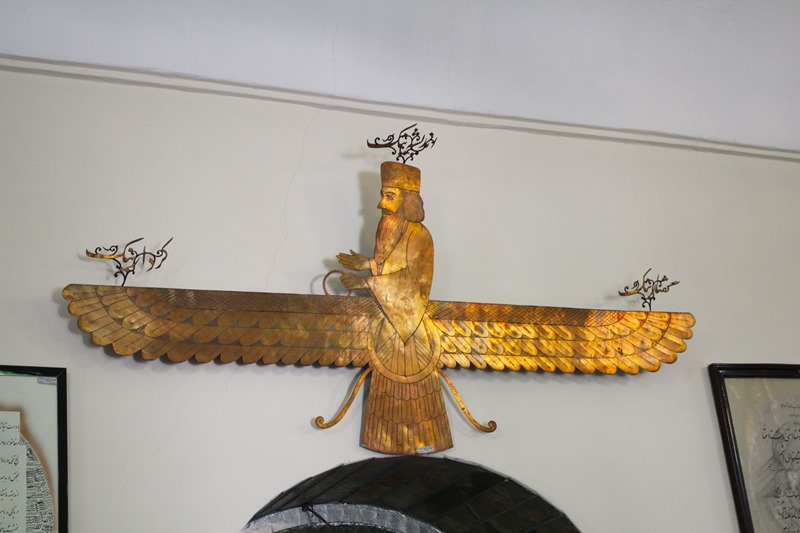The faith is shrinking in Iran and India but growing in the U.S. and Canada.
Most elementary-school boys spend their free time playing videogames or hanging out with friends. Zerkxis Bhandara’s childhood was a bit different. He started training to become a Zoroastrian priest when he was 9.
Article by By Amy DePaul | Wall Street Journal
Mr. Bhandara, whose family traces its lineage to a 12th-century Indian cleric, was born into the role. But the 25-year-old graduate student from Irvine, Calif., pushed back on his early religious obligations. “Oh gosh, I was a bad student,” he recalls. There were classes. Homework. “Like every 9-year-old, I would rather do any other thing.”
Yet by 11 he became an ordained Zoroastrian priest—helping his father preside over weddings, death prayers and youth initiation ceremonies. In high school he wore religious garb under his regular clothes—a white undershirt called a sudreh and a knotted sash, or kusti. “It dawned on me,” he says. “I have to be an example for the community.”
Now he finds refuge at his community’s fire temple, the Zoroastrian house of worship, which hosts a gas flame that never goes out. “To Zoroastrians, fire is the physical form of God’s energy. It’s in all Zoroastrian rituals,” Mr. Bhandara explains. “We say that the fire has warmth and light. Light is a metaphor that cuts through the darkness of ignorance, bringing one face to face with the truth of the divine.”
The faith has taken a long journey from its origins in ancient Persia to the converted church in Orange, Calif., where Mr. Bhandara worships today. Zoroastrianism is arguably the world’s first monotheistic faith, with the oldest remains of fire temples dating back 4,000 years. The supreme deity in the faith is Ahura Mazda. Zoroaster, or Zarathustra in ancient Persian, was actually a prophet after whom the religion came to be known among Westerners.
Cyrus the Great, founder of the first Persian Empire circa 550 B.C., was a Zoroastrian. While Persia served as an incubator for the faith, a group of followers migrated to India following the seventh-century Muslim conquest. They thrived there. For more than 1,000 years India and Iran were the two areas most closely associated with Zoroastrianism, but that’s changing. Indian Zoroastrians began arriving in the U.S. and Canada in the 1960s and ’70s in relatively large numbers, while Iranian Zoroastrians came after the 1979 Islamic revolution.
No one knows exactly how many practice the faith around the globe today, but estimates are between 100,000 and 200,000. Indian Zoroastrianism is veering toward extinction as a result of low birthrates, and Iranian figures are harder to come by but much lower. Yet North American Zoroastrians likely have doubled, to as many as 35,000 in the past 15 years. That’s mostly due to immigration—and possibly some conversions.
Along with Mr. Bhandara’s Southern California temple, three new American houses of worship have been established in the past four years, from New York to Texas. Some of the faithful look to these high-profile venues as a hopeful sign.
“Now Zoroastrians can do their prayers and rituals and religious classes,” says Dolly Dastoor, former president of the Federation of Zoroastrian Associations of North America. She says that the new temples have strengthened the community and “because of that, there is a little revival of the religion over here.”
The religion has adapted as it builds a new life in the West. But change has caused some tension. Converts and children born of mixed-faith marriages are not always viewed as Zoroastrian among more-orthodox practitioners.
Indian immigrant Dilnavaz Bamboat of Milpitas, Calif., whose husband is Hindu, would not be able to raise her 5-year-old son officially as a Zoroastrian in her home community in Mumbai. But at her temple in California, he can take part in the youth initiation ceremony. There are many mixed marriages at her temple, which she says welcomes newcomers. Thanks to this openness, her community is looking for a larger venue.
“The way the community’s going in India, it’s definitely going to peter out,” Ms. Bamboat says. “I have a feeling it will morph and thrive in North America and elsewhere in the world.” But that may require reuniting Zoroastrian Indians, known as Parsis, and Iranian-American Zoroastrians, which have been riven by history for a millennium.
At Ms. Bamboat’s temple the two groups worship separately but maintain friendly relations. Zoroastrian leaders in North America hope this cordial cooperation can grow into something deeper and lasting. The survival of the faith may depend on it.
Ms. DePaul is a writer in Irvine, Calif.

